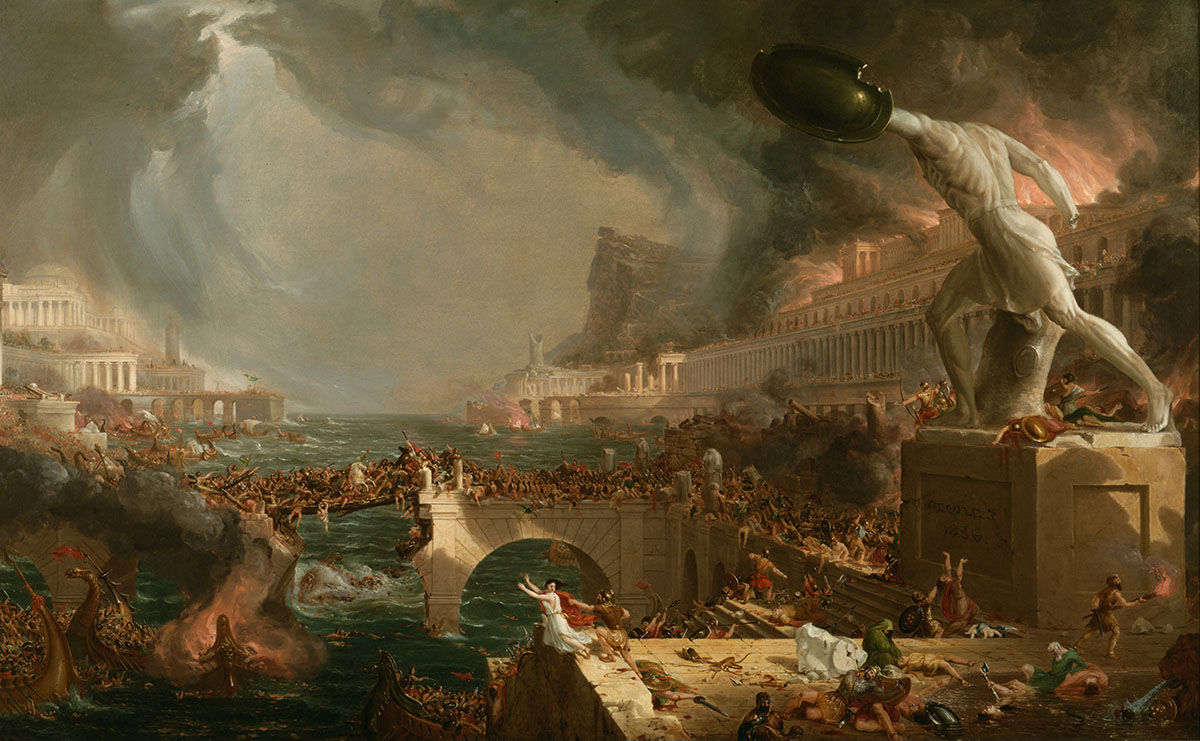The Visigoths sack Rome
Richard Cavendish describes the attack, on August 24th 410, that signalled the beginning of the end of the Western Roman empire

At its height the Roman Empire stretched from Britain and the Atlantic to North Africa and Mesopotamia. In the fourth century AD, however, what Pliny the Elder had called the ‘immense majesty of the Roman peace’ was menaced by invasions of Germanic peoples from beyond the frontiers of the Rhine and the Danube. Among them were the Visigoths, whose leader from around 395 was a chieftain in his mid-20s named Alaric. That same year also saw the death of the Emperor Theodosius the Great, after which the Roman Empire was divided into eastern and western halves under his sons, Arcadius in the east and the ten-year-old Honorius in the west. Honorius’s capital was moved from Rome to Ravenna, which was more easily defended.
Honorius’s regent was his father’s choice, an able general called Stilicho, himself half-German and half-Roman and who kept a loyal German bodyguard. In the early 400s Alaric, who had been attacking the Romans in the Balkans, turned to repeated invasions of Italy, which Stilicho repelled. He hoped to draw the Visigoths into an alliance against the eastern Romans, but now hordes of other Germanic warriors invaded the western empire across the Rhine. In 408 Stilicho was beheaded in Ravenna as a traitor who, it was claimed, had conspired with Alaric to put his own son on Honorius’s throne.
What Alaric really wanted was land on which his people could settle and an accepted place within the empire, which the authorities in Ravenna would not give him. Needing to keep his followers well rewarded, he marched on Rome and besieged it until the Roman senate paid him to go away. In 409 he attacked Rome again and was able to set up a temporary emperor, Priscus Atallus, who did not last long. In 410, with the authorities in Ravenna still refusing his demands, Alaric led his warriors against Rome once more.
The Visigoths appeared outside the city in force and the senate prepared to resist, but in the middle of the night rebellious slaves opened the Salarian Gate to the attackers, who poured in and set fire to the nearby houses. ‘Eleven hundred and sixty-three years after the foundation of Rome,’ Gibbon pronounced, ‘the Imperial city, which had subdued and civilised so considerable a part of mankind, was delivered to the licentious fury of the tribes of Germany and Scythia.’
The licentious fury was not as bad as it could have been. Peter Heather, Professor of Medieval History at King’s College, London, has called it ‘one of the most civilised sacks of any city ever witnessed’. The palaces of the aristocracy were looted, Romans who resisted were killed and women raped by the Visigoths or by slaves who took the opportunity to revenge themselves on their masters. Yet not many buildings and monuments were destroyed and it was said that the attackers did not slaughter nearly as many of the inhabitants as they might have.
Being Arian Christians, the Visigoths respected Christian sites and treasures. According to one story, a group of them refused to steal rich gold and silver vessels when told that they belonged to St Peter and on Alaric’s orders the sacred objects were carried safely through the streets to St Peter’s Church, respectfully accompanied by a throng of Christian citizens who were only too glad to find sanct-uary there themselves. St Augustine told this story in City of God to help rebut allegations by pagans that the sack of Rome was the fault of the Christians, who had enraged the city’s pagan gods.
The Visigoths withdrew from the city after three days. Lumbering slowly along with their weighty spoils and the prisoners they had taken as slaves or for ransom, they moved south along the Appian Way, plundering as they went. One of the captives they had taken in Rome was Honorius’s 20-year-old half-sister Galla Placidia, who was respectfully treated.
Intending to find somewhere to settle in North Africa, the Visigoths had reached Calabria when Alaric, now aged about 40, suddenly fell ill and died near modern Cosenza. He was buried in a river bed, with a wealth of grave goods to see him right in the next world, in a spot which was afterwards kept secret. His successor was his brother-in-law Athaulf, who after negotiations with the authorities in Ravenna led the Visigoths to the south-west of France, where they established their own kingdom. In 414 Athaulf married Galla Placidia, who thus became queen of the Visigoths. After Athaulf’s death, through an extraordinary turn of events she became empress of Rome.
The sack of the city sent a thrill of horror round the Roman world, which has been echoed ever since: ‘In one city,’ St Jerome wrote, ‘the whole world perished.’ By the end of the fifth century the Roman Empire in the west was no more.




